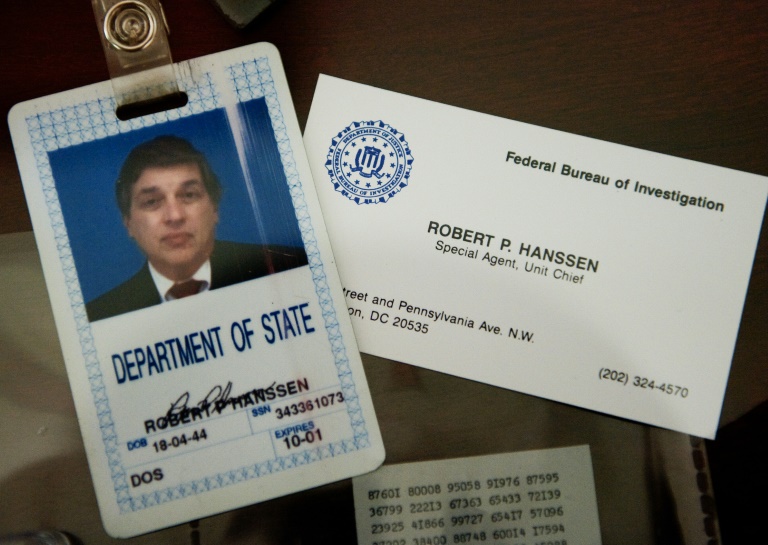Notorious FBI double-agent Robert Hanssen dead

The ID bagde and business card of the former FBI agent Robert Hanssen, who spied for the Soviets, are seen inside a display case at the FBI Academy in Quantico in 2009
Washington – Robert Hanssen, the notorious FBI double agent who secretly fed Russia some of America’s deepest secrets in the 1980s and 1990s, died in a top-security prison Monday, prison officials said.
Offering himself to Soviet military intelligence in 1985, Hanssen traded government secrets and the identities of US moles in the Soviet and Russian governments in exchange for diamonds and hundreds of thousands of dollars.
Because he was in the FBI’s crucial New York counterintelligence department, tasked with chasing down foreign spies, he was able to cover his tracks as he ostensibly investigated Moscow’s agents in the United States.
He was finally caught at a dead drop for exchanging messages with his Russian handlers in suburban Virginia just outside Washington on February 18, 2001.
A year later he was sentenced to life in prison with no possibility of parole.
Hanssen, 79, was found unresponsive early Monday in the ultra-high-security US prison in Florence, Colorado, and was later pronounced dead, according to a prison statement.
The FBI called him “the most damaging spy in bureau history.”
Hanssen joined the FBI in 1976 after first serving as a policeman in Chicago.
Nine years later he took a position in counterintelligence in the New York City office, where agents invested huge amounts of time tracking and trying to recruit Soviet officials at the United Nations.
Instead, within a short time he offered his services to the other side under the name “Ramon Garcia” and even his handlers did not know his true identity.
At the time that he was caught, he was considered the most damaging mole ever to pass US secrets to a foreign government, with thousands of classified US documents handed over to the Soviets, and later to the Russians.
Those included US nuclear war plans, software for tracking spying investigations, and the identities of US sources in Moscow, including Dmitri Polyakov or “Tophat,” a Soviet general who fed his country’s secrets to the United States between the 1960s and 1980s.
Polyakov was arrested in 1986 and executed several years later.
Believed to have been motivated by money and intrigue rather than ideology, Hanssen reaped some $1.4 million in cash and diamonds for his betrayals.
While for several years the FBI and CIA knew there was a well-placed informant in their ranks, Hanssen was for a long time not a top suspect.
He had a wife and six children, lived frugally, and mixed closely with Washington’s conservative Catholic elite.
US investigators eventually turned more attention to Hanssen with small bits of information provided by a Russian defector.
He was secretly tracked and recorded in his office for months before being caught at the Virginia dead drop.
In May 2002 he pleaded guilty to 15 counts of espionage in exchange for a prosecution agreement not to seek the death penalty.
“I apologize for my behavior. I am shamed by it.” Hanssen said at his sentencing.
“I have opened the door for calumny against my totally innocent wife and children,” he said. “I’ve hurt so many deeply.”
